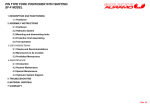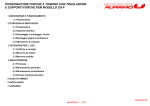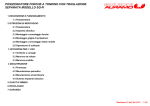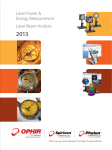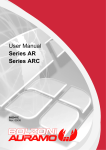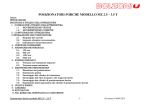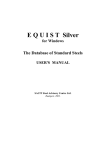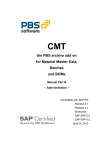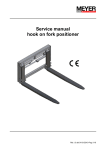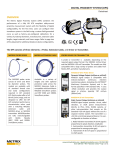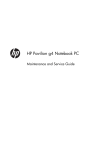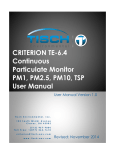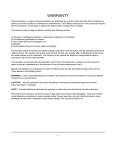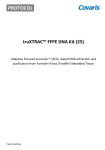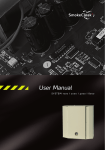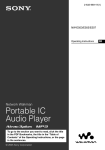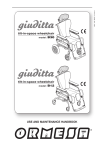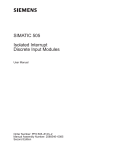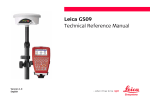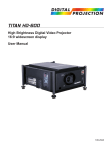Download bar forks positioner with shift and fork supports fem
Transcript
BAR FORKS POSITIONER WITH SHIFT AND FORK SUPPORTS FEM SG-F MODEL 1 DESCRIPTION AND OPERATION 1.1 Positioner 2 ASSEMBLY INSTRUCTIONS 2.1 Positioner 2.2 Hydraulic system 2.3 Forks assembly and disassembly 2.4 Safety grid assembly 2.5 Testing 3 USER INSTRUCTIONS 3.1 Controls and recommendations 3.2 Manoeuvres to avoid 3.3 Prohibited manoeuvres 4 MAINTENANCE 4.1 Introduction 4.2 Scheduled maintenance 4.3 Extraordinary maintenance 4.4 Hydraulic system layout 5 TROUBLESHOOTING 6 RECYCLING 7 WARRANTY Revision 01 dated 30-10-13 1 / 22 BAR FORKS POSITIONER WITH SHIFT AND FORK SUPPORTS FEM SG-F MODEL 1 DESCRIPTION AND OPERATION Fig.001 1.1 Positioner (FIG.001) Device for positioning the loading forks (the load is supported by the chrome plated bars - super clean material 42CrMo4) with cylinder-driven supports The loading forks are hooked to the FEM of the fork support. The supports are operated by cylinders sliding on a chrome bar with self-lubricating INA bushings. The supports are equipped with scrapers and grease nipples to lubricate the bushings' chamber should it be necessary. The screws and fittings are surface treated to prevent any attack by rust. A safety grid can be applied by means of bolts and washers (without any welding and/or drilling). The hydraulic system is connected via inlets positioned depending on the type of forklift mast. The connection fittings have 24° cone metric thread DIN 3861 (12L or 15L). The seal of the fittings for the positioner hydraulic system is made with O-ring and retaining washer. The hydraulic system for the positioning of the forks is equipped with a valve to ensure a perfect synchronism of the forks. The side-shift is performed by means of an additional cylinder to optimize the movement. 2 ASSEMBLY INSTRUCTIONS 2.1 Integral Positioner Assemble the positioner onto the plate of the forklift according to the instructions of the mast itself. Connect the system on the mast of the forklift to the fittings of the equipment, tightening according to the regulations of the fittings used. Revision 01 dated 30-10-13 2 / 22 BAR FORKS POSITIONER WITH SHIFT AND FORK SUPPORTS FEM SG-F MODEL 2.2 Hydraulic system (Fig.002) 2.2.1 Connect, with flexible hoses complete with terminal fittings, the system on the mast of the forklift to fittings "Q1 (forks opening)" and "Q2 (forks closure)", Q3 (left side-shift)", Q4 (right side-shift) of the equipment, tightening the fittings used according to regulations. 2.2.2 Perform some test movements to check the perfect hydraulic seal of the fittings, the speed and the synchronism of the forks movement. In the event of an oil leak, remove the affected fittings and clean them thoroughly. The synchronism of the forks is guaranteed by the valve. See the table at the end of section 4.4 for the flow rates of the oil and recommended pressures. 2.2.3 At this point perform some unloaded side-shift manoeuvres, as far as the end of stroke in both directions and hold under pressure for a few seconds. Then carry out a leak-proof control of the hydraulic connections. Any oil leaks require the disassembly and cleaning of the fittings. Tighten them to the correct torque in accordance with the regulations. Q3 Q1 Q4 Q2 Fig.002 Revision 01 dated 30-10-13 3 / 22 BAR FORKS POSITIONER WITH SHIFT AND FORK SUPPORTS FEM SG-F MODEL 2.3 Forks disassembly and assembly 2.4.0 Hook the fork support with a rope suitable for the weight to be handled 2.4.1 Secure nut "c" with hex wrench "a" on the ear and loosen the front nut "d" with socket wrench "b". (Fig.004) 2.4.2 Remove cover “X” by loosening the 4 screws with an mm Allen key. (Fig.005) 2.4.3 Attach the fork support with a cable. 2.4.4 Withdraw the rod “Y”. (Fig.005) 2.4.5 Withdraw the fork support. (Fig.005) 2.4.6 For assembly, position the fork support and fully insert rod “Y”. (Fig.005) 2.4.7 Repeat the operations in reverse from point 2.4.3 to point 2.4.1 b Fig.004 Fig.005 d c X Y a a Revision 01 dated 30-10-13 4 / 22 BAR FORKS POSITIONER WITH SHIFT AND FORK SUPPORTS FEM SG-F MODEL 2.4 Safety grid assembly (Fig.006) 2.4.1 Position the grid on the plates welded to the frame. Bolt the grid with TCEI M16x50 Cl. screws 10.9 UNI 5931 (DIN 912) and Ø17x24 knurled washers as in the picture. Tightening torque 190Nm (133 Ft/Lbs). 2.5 Final Testing After having completed procedures as per point 2.1, 2.2, 2.3, and possibly 2.4 , perform a few full travel side-shift manoeuvres (not fork positioning) going to the end stop and exercising pressure for a few seconds with the maximum rated load on the forks. Check the perfect seal of the hydraulic connections. Any small oil leaks require the disassembly and cleaning of the fittings. Tighten them to the correct torque in accordance with the regulations. Fig.006 Revision 01 dated 30-10-13 5 / 22 BAR FORKS POSITIONER WITH SHIFT AND FORK SUPPORTS FEM SG-F MODEL 3 USER INSTRUCTIONS 3.1 Controls and recommendations - Introduce the loaded fork as centrally as possible - Keep the load close to the ground for greater stability of the forklift when manoeuvring - Keep the load tilted (tips of the fork raised) during the movement of the forklift - Act gently on the command levers to avoid a sudden burst of pressure in the hydraulic circuit compromising the stability of the load - Adapt the speed of the forklift to the stability and nature of the load and the difficulties caused by spaces and dimensions - Pay attention to inclined surfaces and the unevenness of the ground since these limit the stability of the load - Before introducing the forks, adjust their position so that no force is exerted against the foot of the pallet 3.2 Manoeuvres to avoid - Moving loads in excess of the nominal load - Moving an unstable load - Picking up a load with a single fork even if of a low weight - Moving a flanked load using the load already on the forks - Performing forklift movements or manoeuvres fast with the load lifted high - Performing side-shift or positioning travel of the forks with the load on the forks and forklift moving - Follow al other instructions indicated in the forklift's user manual 3.3 Prohibited manoeuvres - It is not a clamp (do not to use the forks to secure the load in opening or closing) - Use the equipment for purposes other than those for which it was designed - Operate the movements control lever when the equipment is under maintenance - Use the forklift if visibility is poor due to the oversize of the load - Tamper with the equipment - Linger in the working area of the equipment or the forklift; - Use the equipment if the structure is deformed, however slight, or there is a malfunction - Follow al other instructions indicated in the forklift's user manual Revision 01 dated 30-10-13 6 / 22 BAR FORKS POSITIONER WITH SHIFT AND FORK SUPPORTS FEM SG-F MODEL 4 MAINTENANCE 4.1 Introduction The equipment is delivered with guides lubricated with high quality grease, so as to ensure normal adjustment and polishing of the sliding surfaces in the initial period of operation. The user should grease the bushings sliding zone on the chromed bar. The recommended lubricant is ISO X M2 grease (SHELL ALVANIA GREASE R2 or equivalent). For the use of the equipment in excessively dusty environments ISO CB 32 oil is recommended (ESSO NUTO 32 or equivalent). The maintenance indicated below relates to the correct use of equipment in a slightly dusty environment. Revision 01 dated 30-10-13 7 / 22 BAR FORKS POSITIONER WITH SHIFT AND FORK SUPPORTS FEM SG-F MODEL 4.2 Scheduled maintenance (Fig.007) 4.2.1 Every 1000 hours. - Check the screw tightness torque at points “C2”. (17 mm Allen key; tightening torque 700 Nm). - Check the screw tightness torque at points “C3” (12 mm Allen key; tightening torque 235Nm ). - Check the hydraulic seal of the fittings. - Greasing in points “g1”, ”g2”. - Check the general condition of the equipment. - Specific control of the condition of the hoses. Control of the fork support rollers integrity. - Control the hydraulic connections (if necessary, tighten the fittings to the cylinders according to the regulations of the fittings used). - check on the sealing of cylinder gaskets (if necessary or as a result of a leak, dismantle the cylinders according to the instructions provided at points 4.3.1, 4.3.5). C2 Fig.007 g2 g2 C3 g2 g1 g1 g2 C2 Revision 01 dated 30-10-13 8 / 22 BAR FORKS POSITIONER WITH SHIFT AND FORK SUPPORTS FEM SG-F MODEL 4.2.2 Every 2000 hours - In addition to that indicated in the previous point, carry out: - The control of the cylinder stems and the guide bushings; the scratched or dented stem and scratched or worn bushings, as well as the excessive play of the stem (> 0.25 mm. or 0.001 inches) requires the replacement of parts. - Checking of sliding rollers - Replace the shoes when the thickness is less than 4.5 mm, even only of one side. Revision 01 dated 30-10-13 9 / 22 BAR FORKS POSITIONER WITH SHIFT AND FORK SUPPORTS FEM SG-F MODEL 4.3 EXTRAORDINARY MAINTENANCE U01 U01 U02 Fig.008 4.3.1 Preliminary operations - Before performing any extraordinary maintenance, turn off the forklift and remove the pressure in the supply circuit. - Make sure that the pump is not engaged and the lever of the distributor is not operated during the entire maintenance operation. 4.3.2 Disassembly of the fork shift right cylinder (Driver's view) (Fig.008) - Remove the hydraulic circuit connection pipes from the right cylinder (Driver's view) observing the precautions mentioned in section 4.3.1 - Hold the opposite hex with the ch50 wrench "UO2" and loosen nut with socket wrench “U02” ch50. - Loosen the nut on the bulkhead with socket wrench ch50 “U01”. - Remove the cylinder. To reassemble the cylinder perform the operations in reverse order. Revision 01 dated 30-10-13 10 / 22 BAR FORKS POSITIONER WITH SHIFT AND FORK SUPPORTS FEM SG-F MODEL 4.3.3 Disassembly of the fork shift left cylinder (Driver's view) (Fig.009) U02 U02 U02 Fig.009 - Remove the hydraulic circuit connection pipes from the left cylinder (Driver's view) observing the precautions mentioned in section 4.3.1 - Hold the opposite hex with the ch50 wrench "U02" and loosen the nut with socket wrench “U02” ch50. - Loosen the nut on the bulkhead with socket wrench ch50 “U01”. - Remove the cylinder. To reassemble the cylinder perform the operations in reverse order. Revision 01 dated 30-10-13 11 / 22 BAR FORKS POSITIONER WITH SHIFT AND FORK SUPPORTS FEM SG-F MODEL 4.3.4 Disassembly of the positioner side-shift cylinder (Fig.010) - Fully open the fork. - Switch off the forklift, release the pressure in the feeding circuit, make sure that during the intervention the pump does not get engaged and that the distributor's lever is not activated. - Remove the hydraulic circuit connection pipes “T1” and “T2” from the cylinder "C" observing the precautions mentioned in point 4.3.1 - Remove the two snap rings “S1” and “S2” with the pliers. - Rotate the cylinder as indicated by the arrow in Fig.010 to remove it from the pins. - Remove the cylinder. - For reassembling, carry out operations in the reverse order T1 Fig.010 T2 C S1 S2 Revision 01 dated 30-10-13 12 / 22 BAR FORKS POSITIONER WITH SHIFT AND FORK SUPPORTS FEM SG-F MODEL 4.3.4 Disassembly and reassembly of the fork support lower sliding roller C D B A - Having removed the fork support (see point 2.4), loosen dowel "A" with a 4 mm Allen key - Extract the pin “B”. - Remove the roller “C”. - Check the wear of the bushing “D” and replace it if necessary. - Having carefully cleaned, reassemble by performing all the operations described above in reverse order. Revision 01 dated 30-10-13 13 / 22 BAR FORKS POSITIONER WITH SHIFT AND FORK SUPPORTS FEM SG-F MODEL 4.3.5 Replacement of the fork shift cylinder seal (Fig.011) cs04 cs06 cs04 cs05 cs03 cs03 cs06 Cs01 cs02 Fig.011 Det.”A” - After having performed one or more operations as per point 4.3.2 and/or 4.3.3. - Unscrew the cap "cs05", with a pin wrench, and remove it along with the stem "cs02" and parts "cs03", "cs04" and "cs06" of the cylinder casing - Seal replacement procedures “cs01”, “cs03”, “cs04”, “cs06”. - The reassembly of the cylinder must be performed in reverse order to that indicated above, with particular attention to cleaning and checking the exact orientation of the seals “cs03”, “cs04”, “cs06” (Det. "A") - The same disassembly and replacement method of seals is valid for the right cylinder (driver's view) of the supply system. Revision 01 dated 30-10-13 14 / 22 BAR FORKS POSITIONER WITH SHIFT AND FORK SUPPORTS FEM SG-F MODEL 4.3.6 Replacement of gaskets and of the shift cylinder's ball joint (Fig.012) cs01 cs07 cs04 cs05 cs03 cs02 Cs10 cs09 cs09 Cs10 cs08 cs08 cs06 Fig.012 - After having performed one or more operations as per point 4.3.2 and/or 4.3.3. - Unscrew the "cs05” plug, with a pin wrench. - Extract spring pin “cs07” and unscrew piston “cs08”. - Extract stem “cs02” and parts “cs03” , “cs04” and “cs06” from the cylinder casing Det. “A” - Proceed with the replacement of gaskets “cs01”, “cs08”, “cs04”, “cs06”,” cs03” - To remove ball joint “cs09” extract seeger “cs10” - The reassembly of the cylinder must be performed in reverse order to that indicated above, with particular attention to cleaning and checking the exact orientation of the seals “cs03”, “cs04”, “cs06” (Det. "A") Revision 01 dated 30-10-13 15 / 22 BAR FORKS POSITIONER WITH SHIFT AND FORK SUPPORTS FEM SG-F MODEL 4.3.6 Equipment restoration After each maintenance operation, restore the equipment to the initial condition and perform the tests referred to in point 2.5. 4.4 HYDRAULIC SYSTEM LAYOUT (forks positioning) (Fig.013) Q2 Q3 Q1 Q4 Q4 Q3 Q1 Q2 - To spread/open the forks, introduce pressure in "Q1" - To approach/close the forks, introduce pressure in "Q2" - Left shift (view from the operator side) “Q3”- Right shift (view from the operator side) “Q4" Revision 01 dated 30-10-13 16 / 22 BAR FORKS POSITIONER WITH SHIFT AND FORK SUPPORTS FEM SG-F MODEL Hydraulic layout Fig.013 Revision 01 dated 30-10-13 17 / 22 BAR FORKS POSITIONER WITH SHIFT AND FORK SUPPORTS FEM SG-F MODEL Table of the recommended oil flow rates and operating pressures. • Fork positioner oil flow rate: minimum 30 l/min. recommended 40 l/min. maximum 60 l/min • Hydraulic functions and recommended pressures: Fork positioner pressure Min. 14 MPa (maximum pressure at the distributor 25 MPa) side-shifter pressure min. 12 MPa, max. 22 MPa (maximum pressure at the distributor 25 MPa) Revision 01 dated 30-10-13 18 / 22 BAR FORKS POSITIONER WITH SHIFT AND FORK SUPPORTS FEM SG-F MODEL 5 TROUBLESHOOTING FAULTS 5.1 The forks do not shift CAUSES Obstructions or accumulation of dirt on sliding tracks Insufficient hydraulic pressure Hydraulic circuit blocked or broken Leak inside the cylinder (worn seals) 5.2 The shifting of the forks is too slow Insufficient oil flow Obstructions in the hydraulic circuit Leak inside the cylinder (worn seals) 5.3 The shifting of the forks is too fast High oil flow 5.4 The forks do not shift in a synchronized manner Obstructions or accumulation of dirt on sliding tracks 5.5 The side-shift does not occur at all Frame deformed Mud or other obstruction on the track of the lower rollers Deteriorated hoses Obstruction in the hydraulic circuit Insufficient pressure Deteriorated pump SOLUTION Remove the obstructions, clean and grease the sliding tracks Control and/or regulation of the pressure delivered by the forklift's pump. Eliminate the obstruction or replace the damaged pipe Control and possible replacement of the seals, see point “4.3.2” and/or “4.3.3” and “4.3.5” Control and regulation of the flow delivered by the hydraulic circuit. Adjust the forklift's oil flow. Eliminate the obstruction or replace the damaged pipe Control and possible replacement of the seals, see point “4.3.2” and/or “4.3.3” and “4.3.5” Control and regulation of the flow delivered by the hydraulic circuit. Adjust the forklift's oil flow. Remove the obstructions, clean and grease the sliding tracks Replace the frame removing it as in point 4.3.5 Clean the track and lubricate shoes as in point 4.2.1 Replace the pipes Eliminate the obstruction Increase the pressure Repair or replace the pump of the forklift Revision 01 dated 30-10-13 19 / 22 BAR FORKS POSITIONER WITH SHIFT AND FORK SUPPORTS FEM SG-F MODEL FAULTS 5.6 The side-shift is too slow 5.7 The side-shift occurs with jolts or irregularly CAUSES SOLUTION Worn sliding rollers After cleaning replace the rollers. Emulsified oil, the pump draws in air Deteriorated pump Insufficient pressure Check the oil level in the tank of the forklift Repair or replace the pump of the forklift Increase the pressure Air in the hydraulic system Bleed the forklift's system and check the oil level Air in the system Bleed the system NOTE: If there are difficulties or in the case of defects other than those listed, please contact BOLZONI Technical Support Service. Revision 01 dated 30-10-13 20 / 22 BAR FORKS POSITIONER WITH SHIFT AND FORK SUPPORTS FEM SG-F MODEL 6 RECYCLING 6.1 Replaced parts should be disposed of, as in the case of complete destruction, separately depending on the nature of the material and in compliance with the requirements of the law on the disposal of solid industrial waste. Frame unit Fasteners, piping and other components Welded frame Steel Hoses and fittings Nylon and steel Supports Steel Hydraulic oil Dispose of in compliance with local regulations Fastening of cylinders Steel Bushings Steel and Teflon Chrome bar Steel and chrome Pins, screws, bolts, snap rings Steel Paint Epoxy polyester O-ring rubber Cylinders Steel and chrome Seals Polyurethane Shift cylinder stems Steel and chrome Shoes Polyamide Revision 01 dated 30-10-13 21 / 22 BAR FORKS POSITIONER WITH SHIFT AND FORK SUPPORTS FEM SG-F MODEL 7 WARRANTY BOLZONI S.p.A. warrants all its products for 12 months for an 8-hour-a-day use every working day starting from the date of shipment. If used more than 8 hours per day the warranty period shall be reduced proportionately. The warranty is limited to replacing the parts that the company deems defective due to material or machining defects ex BOLZONI S.p.A. works and does not include labour or travel costs for replacing said parts. It is further understood that recognition of the warranty is void if the anomaly results from an inappropriate use of the product, if commissioning was not carried out according to BOLZONI S.p.A specifications or if non-original parts have been assembled on BOLZONI S.p.A. products. BOLZONI S.p.A products. are not guaranteed for uses that exceed the ratings stated on the plates and in the technical documentation attached to the order. All the equipment manufactured by BOLZONI S.p.A. is covered by insurance for any damage caused to third parties by defective parts or their malfunction; damage arising from improper use or misuse of the equipment is not covered. Revision 01 dated 30-10-13 22 / 22






















